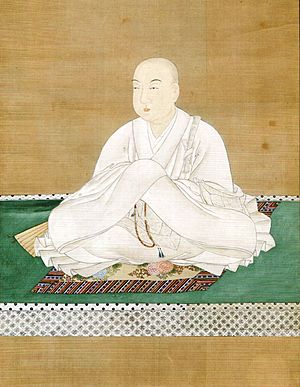Gangyō facts for kids
Gangyō (元慶) was a special time period, or nengō, in Japanese history. It came after the Jōgan era and before the Ninna era. The Gangyō period lasted from April 877 to February 885. During this time, the emperor of Japan was Emperor Yōzei.
Key Events of the Gangyō Era
- January 20, 877 (Gangyō 1): Emperor Yōzei officially became the emperor when he was only 8 years old.
- 877 (Gangyō 1): Visitors from Korea arrived in the Izumo province. However, they were turned away and sent back home.
- 877 (Gangyō 1): Japan faced a big drought, meaning there was not enough rain. People made special offerings at temples like Hachiman and Kamo, and other temples in Ise province, asking for rain. Eventually, it did rain.
- December 32, 878 (Gangyō 2): The previous emperor, Emperor Seiwa, passed away at the age of 31.
- March 4, 884 (Gangyō 8): In the 8th year of Emperor Yōzei's rule, he was removed from his position. The third son of the former Emperor Ninmyō was chosen to take his place.
- March 23, 884 (Gangyō 8): The new emperor, Kōkō, officially accepted his role and duties. This was confirmed in special ceremonies.
More About This Time
- You can learn more about the Japanese calendar and its history from the National Diet Library here.
| Gangyō | 1st | 2nd | 3rd | 4th | 5th | 6th | 7th | 8th | 9th |
|---|---|---|---|---|---|---|---|---|---|
| 877 | 878 | 879 | 880 | 881 | 882 | 883 | 884 | 885 |
| Preceded by: Jōgan |
Era or nengō: Gangyō |
Succeeded by: Ninna |

All content from Kiddle encyclopedia articles (including the article images and facts) can be freely used under Attribution-ShareAlike license, unless stated otherwise. Cite this article:
Gangyō Facts for Kids. Kiddle Encyclopedia.

